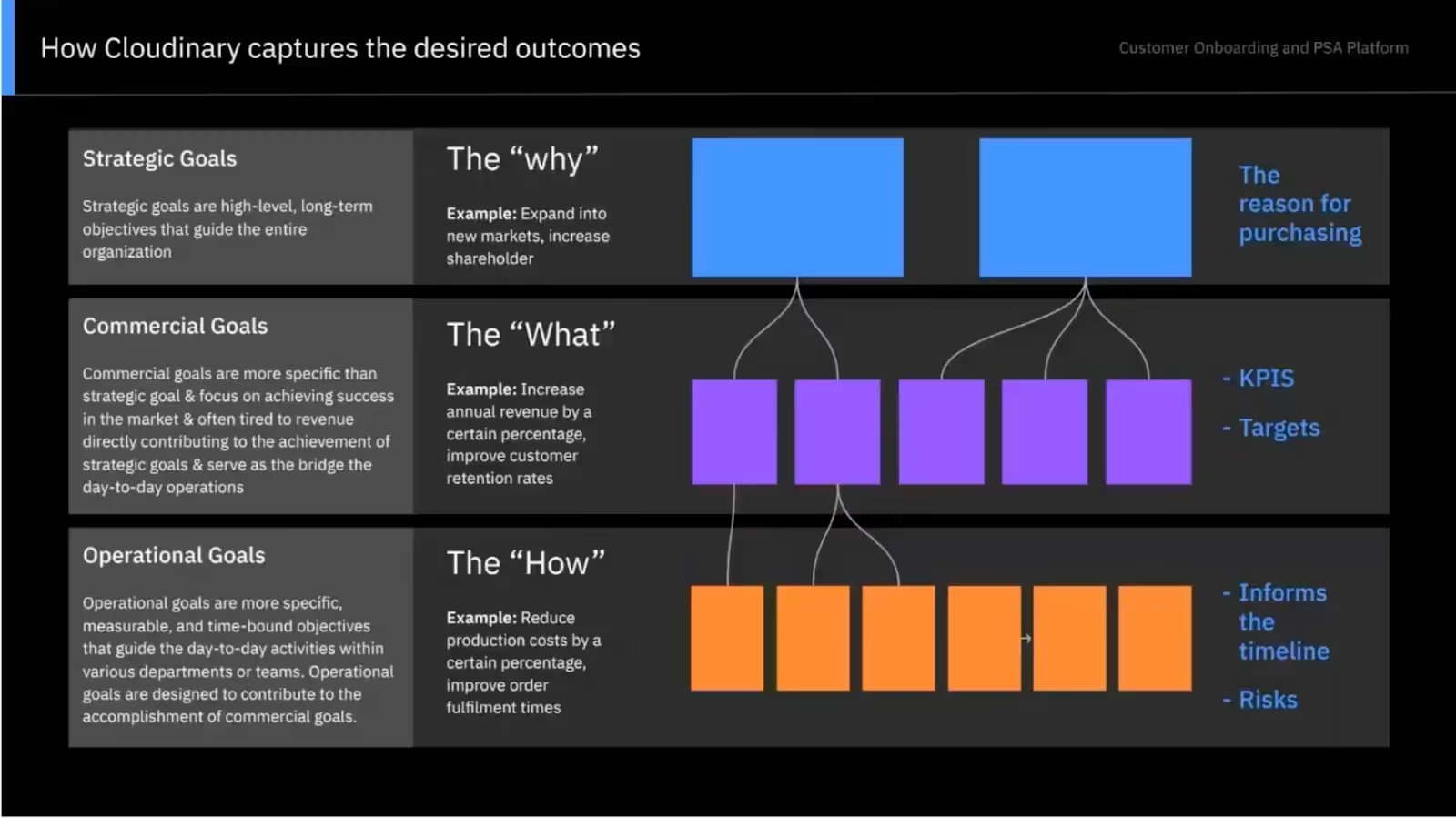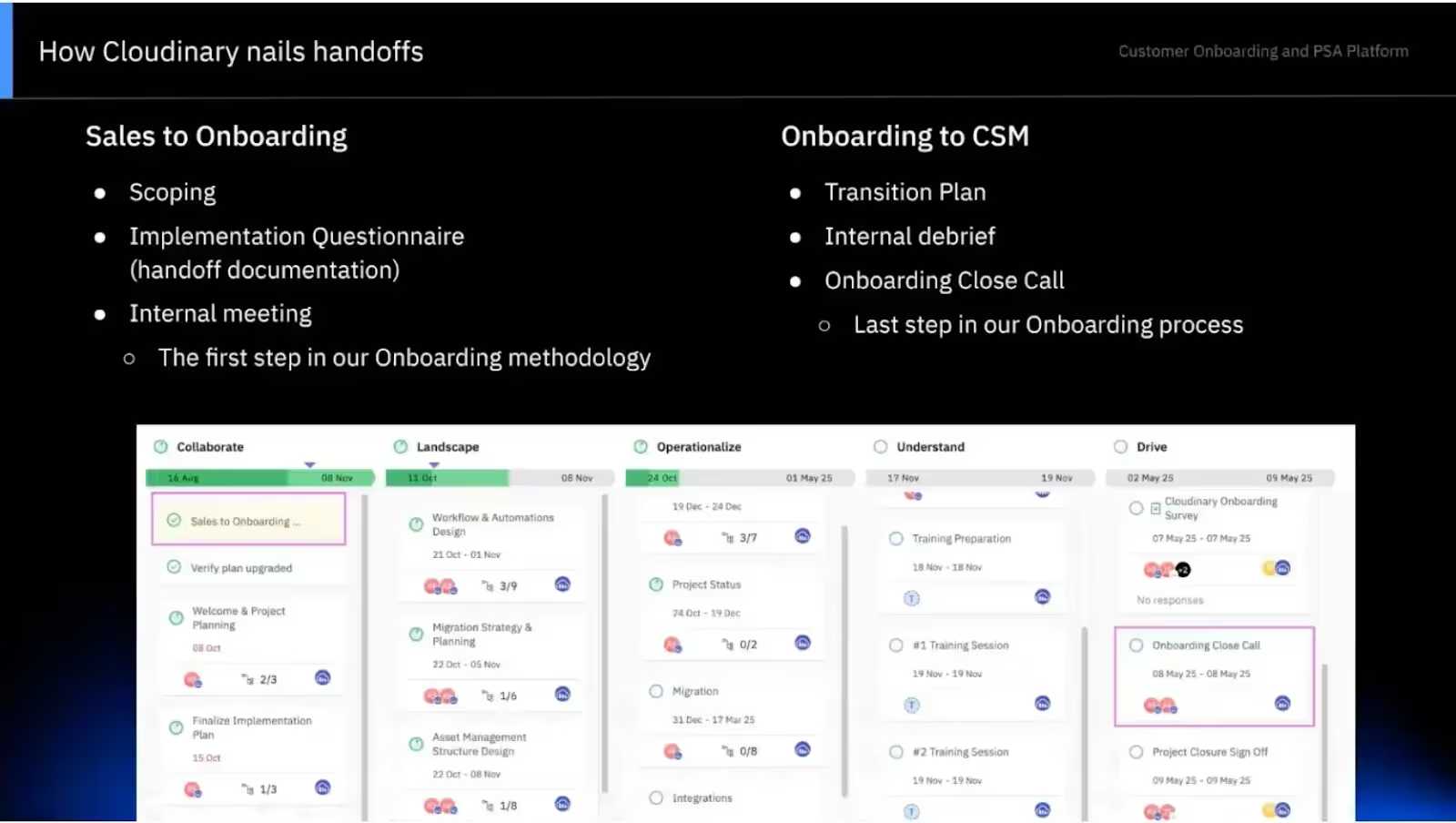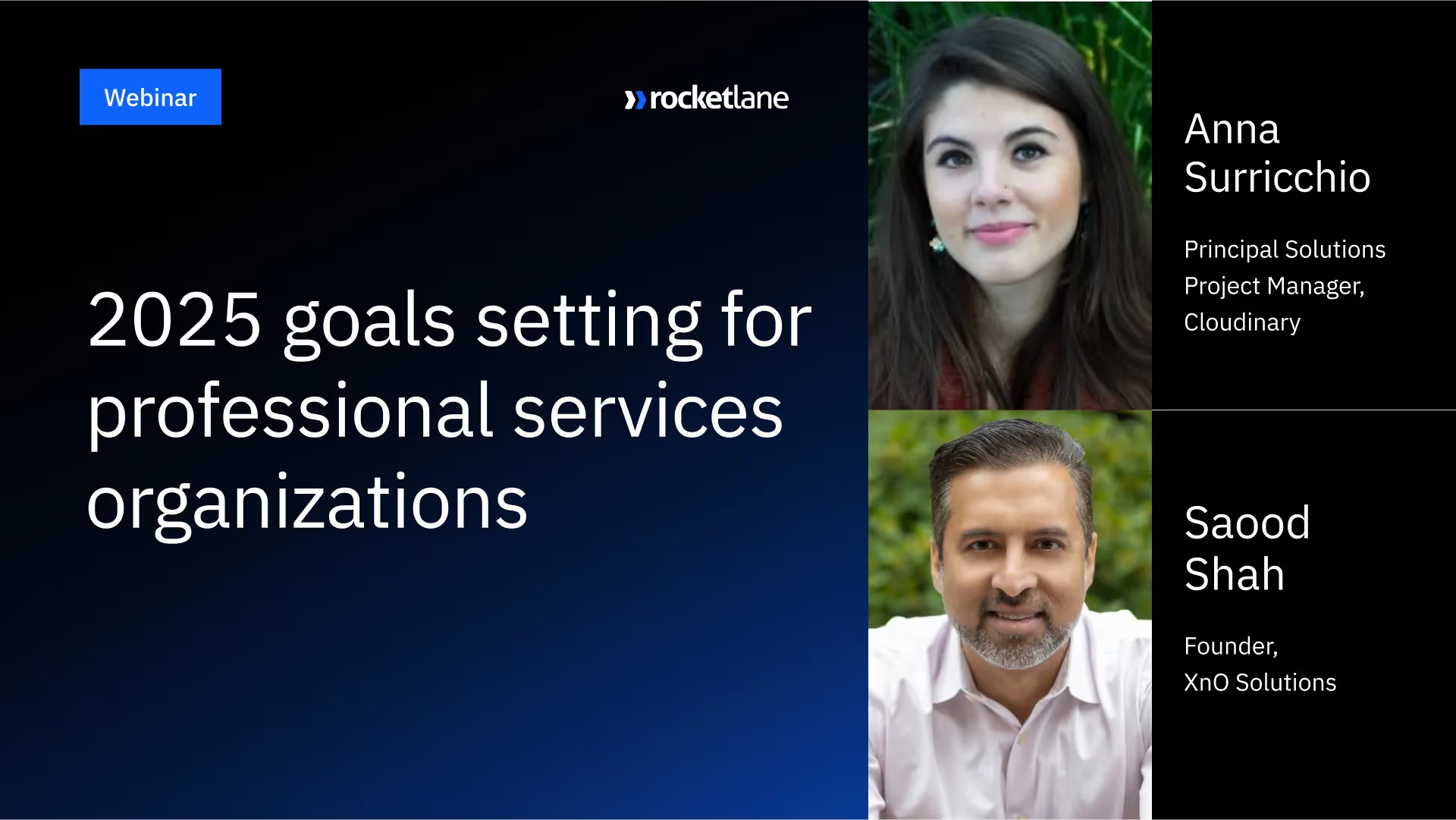When PS teams deliver superior service, they not only drive customer satisfaction but also foster loyalty, thereby reducing churn and contributing to recurring revenue.
In the recent workshop-style webinar, Anna Surricchio, Principal Solutions Project Manager at Cloudinary, and Saood Shah, Founder of XnO Solutions discussed the strategic planning for professional services (PS) organizations. This session was designed for PS professionals eager to align their annual goals with larger company strategies.
Read on for a quick summary of the session that will touch on best practices for planning, as well as practical steps.
Yearly planning for your professional services is essential to ensure that teams are fully aligned with company-wide strategies. This alignment not only enables to fulfill our commitments seamlessly but also allows us to harness our resources effectively, ensuring our team isn't stretched too thin or left underutilized. An effective PS planning approach means aligning capacity and resources with projected demand. This enables professionals to deliver outstanding service while focusing on strategic initiatives and fostering innovation that helps remain competitive.
In a modern view of the professional services environment, PS team goals should derive directly from the broader company objectives. Traditionally, PS organizations have focused on revenue, gross margin, and managing one-time revenue streams through project delivery.
However, today’s PS teams have evolved beyond these boundaries, increasingly impacting metrics like Net Retention Rate (NRR)—a metric traditionally overseen by Sales and Customer Success teams. PS now plays a vital role in customer satisfaction, loyalty, and long-term success by delivering exceptional services and outcomes, all of which contribute to positive NRR. This shift highlights how PS teams can drive not just project revenue but also influence customer sentiment and recurring revenue streams.
As PS teams mature, they impact various metrics differently depending on their maturity stage and the market context, particularly in SaaS environments where metrics like NPS, CSAT, recurring revenue, and churn are paramount.
There are three primary areas where PS can drive measurable impact:
1. Revenue and gross margins
2. Net retention rate (NRR)
3. Customer satisfaction and loyalty, measured by CSAT and NPS.
Focusing on these areas helps streamline strategies and align efforts with broader company objectives.
Revenue and gross margins
Revenue and margins are crucial to a PS team’s financial success, but with so much data, it’s easy to feel overwhelmed. Concentrating on these key metrics can help PS teams navigate these complexities with greater clarity.
- Billable utilization: This metric measures the percentage of time spent on revenue-generating tasks and is foundational for financial performance. High billable utilization directly enhances revenue outcomes.
- Productive utilization: Complementing billable utilization, this metric gauges time spent on customer-focused activities—whether billable or not—providing insight into how well team resources are allocated for client engagement.
- Booking rate vs. Bill rate: The booking rate is the hourly rate at which services are sold, while the bill rate reflects the actual revenue rate after accounting for any non-billable time. By understanding the difference between these rates, professional services teams can better align client work with financial objectives.
- Time-to-value: This metric captures how quickly clients begin to see value, an indicator of onboarding effectiveness and service quality.
- Product adoption: Measured across two dimensions, depth (frequency of use) and breadth (range of features used), product adoption reflects how well customers engage with the service and realize its full potential.
Understanding the interplay of revenue, margin, and resource allocation in SaaS professional services
Maximizing revenue and maintaining healthy margins is complex, demanding close attention to both sales efforts and the resources required for service delivery. As SaaS companies focus on product and customer-centric services, effectively leveraging metrics like billable utilization and delivery efficiency has become crucial for sound financial planning. Here’s a framework for how these elements—demand, supply, margin, come together to impact profitability and revenue growth, providing actionable insights for professional services organizations.
- Demand side: This aspect encompasses the sales-driven demand for services. In terms of available hours, you start with a backlog (previously accumulated hours available to deliver) and add new opportunities as they close. For example, beginning with 750 backlog hours, and closing 20 opportunities at an average booking value of $20,000, we might generate $400,000 in bookings. This equates to approximately 1,400 hours of deliverable work, which added to the backlog would bring the available hours to 2,200. This calculation helps in forecasting service capacity and demand fulfillment for each quarter.
- Supply side: Supply focuses on resource capacity—the number of staff hours available to deliver services. If you have five consultants each working 520 hours a quarter, and you’re targeting 70% utilization, that’s a capacity of roughly 1,800 hours. Matching this supply with the demand gives a clear picture of workload distribution and highlights if there’s excess or a deficit of resources. If demand exceeds supply (e.g., 2,200 hours of demand against 1,800 hours of supply), you’re likely to carry over backlog, influencing the next quarter’s planning.
- Gross margin: Gross margin is the core measure of profitability. Calculating margin involves assessing revenue (the billable hours multiplied by hourly rates) against costs such as salaries, overhead, and other expenses tied to staffing. When the same number of opportunities are closed and staffing levels are maintained consistently each quarter, the margin should remain relatively stable. The goal is to achieve a healthy margin by balancing cost control with revenue growth.
Leveraging partners to address backlog
When demand exceeds internal capacity, strategic use of partner networks can support service delivery without overburdening internal resources. For example, onboarding services, which can require extensive hours and resources, may be outsourced to trusted partners when internal teams are stretched thin. This partner-based model helps manage large backlogs effectively, ensuring client onboarding timelines are met without adding fixed costs. It often creates a win-win scenario, as partners may also refer to future business opportunities.
Key variables in driving revenue growth
Revenue growth in professional services is primarily influenced by two variables: the number of closed opportunities and the number of staff available to deliver those services. To illustrate, if we move from 20 to 30 closed opportunities per quarter, revenue rises significantly. However, scaling up revenue requires an increase in capacity—more consultants or higher productivity among existing ones. Therefore, the balance between adding team members and closing opportunities is essential to avoid strain on delivery capabilities and maintain client satisfaction.
Enhancing margin through efficiency
Margin improvement often requires fine-tuning operational efficiency rather than merely cutting costs. Strategies to drive profitability include increasing billable utilization, enhancing project scope control, and raising the average hourly billing rate. For example, by increasing utilization to 80% and optimizing the mix of high-value services, an organization can grow revenue while keeping costs steady. This approach bolsters margins without reducing headcount, allowing for steady revenue growth with minimal additional costs.
The role of sales alignment in service delivery
A close partnership with the sales team is instrumental in managing service delivery efficiency. An open, collaborative relationship with sales allows for accurate forecasting of service demand and ensures delivery teams are prepared for the types of services being sold. For instance, if sales teams secure a high volume of onboarding projects that require specialized skills, having visibility into the pipeline allows service delivery teams to plan capacity or engage partners proactively. This alignment minimizes scope creep and ensures a smooth client experience from contract signing through project completion.
Net Revenue Retention (NRR)
Net revenue retention (NRR) is no longer solely a Customer Success (CS) metric. PS plays a pivotal role in impacting NRR, making the case for a collaborative approach between PS and CS. Traditionally, these teams often operate in silos with different metrics—PS focuses on project execution, and CS on retention and growth. However, to truly drive NRR, both teams must align on shared objectives, such as customer outcomes, efficiency, and value communication. Let’s dive into how PS can directly impact NRR through three critical elements: outcome orientation, process optimization, and value retention.
1. Outcome orientation
One of the most significant ways PS can enhance NRR is by shifting focus from merely executing onboarding steps to delivering customer-centric outcomes. Rather than solely following a project checklist—such as finalizing integration, setting up data transfers, and checking items off a project plan—PS should prioritize what the customer aims to achieve long-term. Establishing a success plan during onboarding, capturing insights from sales, and aligning on KPIs and potential risks sets the foundation for a solution designed around the customer’s core objectives.
- Building a success plan in onboarding: PS can kick off a success plan by gathering the strategic, commercial, and operational goals shared during the sales cycle. This process helps PS understand why the customer chose the product and what they envision achieving. Translating these insights into specific KPIs not only keeps onboarding relevant but also makes it more meaningful for the customer, as it directly addresses their goals.
- Communicating outcomes to CS: Documenting these outcomes and transferring them to the CS team ensures continuity. CS can then build on the initial success by reinforcing these goals post-onboarding, setting a steady path toward retention and potential expansion.
2. Process optimization: Reducing time-to-value and standardizing delivery
Another area where PS can impact NRR is by optimizing the delivery process to accelerate time-to-value (TTV). TTV is a critical metric for both CS and PS, as customers are more likely to renew or expand their contracts if they start seeing value sooner. This means creating repeatable processes and standardized frameworks that reduce the time it takes for customers to reach their first meaningful outcomes.
3. Minimizing value leakage
A common challenge in the PS-to-CS transition is value leakage, where essential customer insights get lost between sales, onboarding, and post-onboarding. These missed details can disrupt the customer journey and lead to disjointed experiences that impact retention and growth potential. Ensuring clear, comprehensive handoffs between PS and CS minimizes this risk, keeping the customer journey aligned with their goals from onboarding through long-term usage.
Creating customer-centric onboarding at Cloudinary
At Cloudinary, the onboarding process starts with understanding the customer’s strategic, commercial, and operational goals. Strategic goals clarify why the customer selected the solution and outline their long-term vision. Commercial goals, such as KPIs and targets, help PS identify what the customer hopes to achieve, setting TTV benchmarks. Operational goals, meanwhile, address how the solution should function within the customer’s ecosystem, highlighting timeline requirements, risks, and necessary integrations.
To support customer outcomes, PS limits the onboarding scope to a few core features that provide immediate value, ensuring customers aren’t overwhelmed with unnecessary functionalities. The success plan created during onboarding is then handed over to CS, ensuring that post-onboarding, the customer receives consistent support tailored to their goals.

Defining customer outcomes and goals
In any services engagement, the aim is to clarify what customers truly want, moving from an initial, high-level understanding of goals to a detailed plan for achieving them. While sales teams often begin by discussing broad outcomes, it’s through the services engagement that these goals are refined and specified. This deeper exploration uncovers overlooked aspects and shapes the roadmap to success. One key to efficient implementation and quicker time-to-value is standardizing processes, as outcomes can only be improved when they’re thoroughly documented and followed consistently.
Standardizing processes to boost efficiency
For any team, achieving consistent results requires a uniform approach. Without standardization, each team member may take a different approach, which leads to inefficiencies and inconsistencies. By writing down and standardizing processes, teams can reduce obstacles, prepare better, and ultimately execute faster. A consistent methodology not only enhances efficiency but also sparks innovation by providing a reliable foundation from which teams can optimize.
Transitioning from customer success to a dedicated onboarding team
At Cloudinary, the onboarding process was initially led by customer success managers (CSMs) who also had post-onboarding responsibilities. Recognizing the need for specialization, Cloudinary restructured, establishing a dedicated onboarding team. This shift allowed CSMs to focus on customer success post-onboarding and helped streamline the onboarding journey. After implementing a standardized, repeatable methodology, Cloudinary’s onboarding process became more efficient and effective, yielding a detailed project plan for each customer.
Time-to-value: Measuring impact through data
In 2023, Cloudinary's average onboarding time was 214 days. However, with the new standardized approach, this was reduced to 73 days in Q2, with an average of 32 days to reach the initial value milestone. This transformation underscores the power of standardization in accelerating time-to-value. Additionally, the onboarding process includes a structured education phase and a monitoring period to ensure customers are fully equipped to use the platform, further enhancing their experience.
Leveraging tools and playbooks for consistent results
Centralizing resources and templates is crucial to maintaining a standardized approach. At Cloudinary, the team utilizes Rocketlane to share project plans and communicate transparently with customers. Each phase and deliverable has a corresponding playbook in Confluence, providing clear instructions on how to execute tasks. This structure not only keeps documents updated but also enables the team to consistently follow a reliable methodology.

{{demo}}
Streamlining handoffs: The importance of clear transitions
Handoffs between teams are pivotal moments in the onboarding process, comparable to bookends that keep the project organized. Cloudinary participates in pre-sales discussions to ensure comprehensive scoping, which leads to a seamless handover from sales to onboarding. The implementation questionnaire doubles as a transition document, formalizing the onboarding team’s responsibilities. Similarly, the final handover from onboarding to customer success is carefully managed. With different CSMs handling various customer segments, the success plan’s transition phase identifies key areas for focus, ensuring a smooth handover and uninterrupted customer experience.
Aligning implementation pace with customer readiness
To ensure that your implementation pace aligns seamlessly with the customer’s progress, it’s important to begin with a clearly defined success plan. Start by setting achievable goals and diligently communicating them with key stakeholders. By regularly revisiting these expectations and confirming milestones, the implementation manager can align the customer with each next step, minimizing disruptions or mismatches in pacing. In situations where clients require additional time, a standardized onboarding process ensures that the majority of projects stay on track, creating flexibility for customized support in unique cases.
Best practices to improve CSAT and NPS
PS play a critical role in shaping customer satisfaction (CSAT) and Net Promoter Score (NPS) metrics. To maximize this impact, there are three best practices that PS teams should consider implementing.
1. Tailoring the process to the customer
The first best practice is to ensure that customers feel the process is tailored specifically for them. While it’s essential to maintain a standardized process, flexibility is crucial. It’s important to prioritize the implementation steps according to the customer’s preferences and the outcomes they aim to achieve. Aligning the implementation process with customer goals enhances their experience and shows a deep understanding of their unique needs.
2. Optimizing the survey process
Next, the survey process can be a powerful tool if utilized effectively. While many organizations have surveys in place, they often do not leverage them to their full potential. It’s vital to keep surveys concise and straightforward to avoid overwhelming customers. Positive feedback should be highlighted and used as testimonials, while negative responses should be thoroughly analyzed to pinpoint process challenges. This allows teams to address issues proactively and strive to prevent similar negative feedback in the future.
3. Personalizing the customer experience
Lastly, make the onboarding experience more personal, ensuring that customer interactions feel human rather than automated.
- Adding personality to communications fosters a sense of connection and belonging for the customer.
- Prioritizing relationship-building with customers is essential; quality time with them often leads to stronger connections than those with internal teams.
- Creating enjoyable and relatable interactions helps customers feel inspired and excited about the journey.
The evolution of Cloudinary's CSAT and NPS metrics
Cloudinary has transformed its approach to measuring customer satisfaction and loyalty through CSAT and NPS metrics.
With a newly established onboarding team, both NPS and CSAT were integrated into the early process to enhance product adoption—crucial for a SaaS business model. This combination allowed for targeted questions to ensure alignment with customer needs, though, like many organizations, we faced low response rates. Despite this, the collected data validated our approach and provided valuable feedback for adjustments.
To improve response rates, Cloudinary has since adopted a single NPS question strategy, which is strategically linked to performance evaluations and bonuses for the onboarding team. This streamlined approach has proven successful, with NPS increasing significantly from -25 in 2023 to an impressive 85.7, reflecting our commitment to continuous improvement and customer satisfaction.






















.webp)
